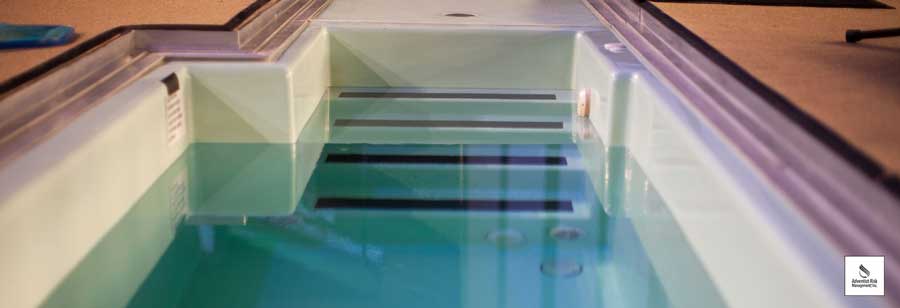Do you remember the day you were baptized? On my baptism day, I was nervous as I climbed into the baptismal tank. The cold water enveloped me, as I searched the audience to spot my family. The baptism service can be a very meaningful moment on one’s Christian journey. It certainly was for me.
In addition to being memorable and meaningful, the baptismal service carries some inherent risks. Here is how to remove some of the hazards surrounding the use of the baptistry.
Baptismal Tank Dangers
- Slips and Falls – Wet surfaces are slippery surfaces. Water splashed around can make getting into and out of your baptismal tank hazardous. Install handrails and non-slip surfaces on steps leading into and out of your baptismal tanks to prevent slips, trips, and falls in your church.
- Electrocution – Using a sound system or electric heating device near water can be deadly. Always test any heating devices before use and turn them off before the baptismal service. Additionally, only use wireless microphones that are attached near the baptismal tanks to prevent electrocution.
- Drowning – Unsupervised children can fall into baptismal tanks and drown. Never leave a filled baptismal tank unattended. Properly drain the tank and secure it following a baptism service.
"Unsupervised children can fall into baptismal tanks and drown. Never leave a filled baptismal tank unattended."
- Burns – Burns can result from water that is heated too hot. Check the temperature of your tank 90 minutes and right before services to be sure the temperature is safe. A temperature of 83°-90° Fahrenheit is a suggested temperature range for baptistry pool water.
- Contaminated Water – Water left sitting in baptismal tanks for days or longer can breed bacteria and mold, creating a dangerous environment for anyone who enters your church. Be sure your tank is drained completely and cleaned out after the service.
- Water Damage - Over time water pipes may leak or burst under floors or behind walls. Moisture can also seep in and damage the tank itself or the surrounding area. Have your church safety officer check your baptism tank annually as part of your seasonal maintenance program.
Baptismal Tank Safety
Protect your members and church equipment by following these baptismal tank safety measures.Before the Service
- Outfit the baptismal tank with an overflow drain. The drain prevents water damage to any equipment and cuts down on slippery surfaces.
- Ensure steps into the tank and the tank bottom have non-slip treads or slip resistant surfaces.
- Install handrails along the steps into the baptistry.
- Test all water heating devices before use.
- Monitor the tank filling process to ensure it fills properly, does not overflow, and to avoid slippery surfaces or water damage.
- Check the water temperature 90 minutes before and again right before use.
- Assign church deacons or elders to guard the tank to ensure no one falls into the baptistry.
- Keep microphones and other electrical equipment from touching anyone in the baptistry. Only use wireless microphones.
- Have towels ready for participants to dry off, thus avoiding a trail of water.
- Prevent slips and falls on wet flooring by having towels ready to mop up wet floors immediately after the baptism.
"Prevent slips and falls on wet flooring by having towels ready to mop up wet floors immediately after the baptism."
After the Service
- Immediately drain the tank after use.
- Turn off water heating device after the baptism.
- Lock doors between the church common areas and baptismal tank to prevent unsupervised children from playing in the baptismal tank area.
- Check faucets for water leaking into the baptismal tank. Don’t allow sitting water, which breeds bacteria
- Clean and sanitize the tank based on the manufacturer’s recommendations


